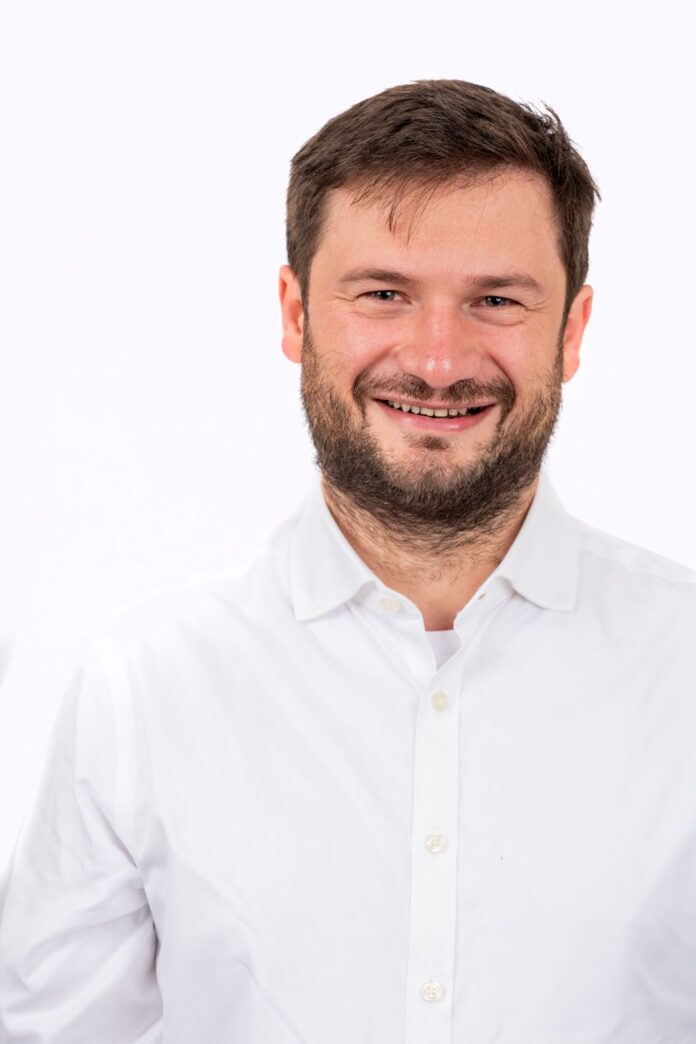It is undeniable that in today’s world, where the focus is on environmental impact and energy efficiency, HVAC systems in buildings are undergoing a significant transformation.
Mechanical engineers are at the forefront of this change, whose innovative approaches to HVAC design are redefining climate control in our living and working spaces.
“The necessity for efficient HVAC systems has never been more pronounced,” says mechanical engineer Ioannis Kalfagiannis. With years of experience in mechanical engineering, he has seen firsthand the evolution of HVAC systems.
Kalfagiannis adds: “With the rise in global temperatures and heightened awareness of energy consumption, the demand for more efficient, eco-friendly HVAC solutions has grown exponentially.
“Now, the goal is no longer just to provide comfort but to do so sustainably.”
Kalfagiannis, an Intermediate Mechanical Building Services Design Engineer at Arup, is currently based in London but has worked on billion-dollar building projects in the United States, Dubai and Denmark.
Celebrated for his exceptional analytical abilities, Kalfagiannis can adeptly address and resolve intricate problems while crafting comprehensive engineering specifications. His extensive technical expertise encompasses various areas, including computer-aided Design (CAD), HVAC designs, energy modeling, and building information modeling.
These multifaceted skills underscore his proficiency in detailed engineering aspects and contribute significantly to his ability to lead and innovate in his field.
Kalfagiannis is also proficient in software like AutoCAD, Revit, and IES and is familiar with various standards and codes, such as ASHRAE, NFPA, and CIBSE Guides.
His academic credentials are equally impressive. Kalfagiannis holds a Master’s degree in Global BIM Management from the Zigurat Global Institute of Technology – University of Barcelona, an MSc in Energy & Sustainability from Heriot-Watt University, Edinburgh, and a BSc in Mechanical Engineering from the Technological Institute of East Macedonia & Thrace, Kavala, Greece.
“What we’re looking at today is a complete rethinking of how we heat and cool our spaces,” says Kalfagiannis.
“Now we need to consider not only the mechanics but how to integrate technology, sustainability, and design.”
One of the most significant advancements in HVAC design is the integration of smart systems and artificial intelligence. Kalfagiannis’s work often involves the use of AI to optimize system performance: “By incorporating AI, we can create systems that learn and adapt to their environment, significantly reducing energy consumption,” he explains.
Kalfagiannis is also a strong advocate for customizable and modular HVAC designs: “Every building has its own unique set of needs and challenges. A one-size-fits-all approach is no longer viable,” he says.
His designs often involve modular components that can be easily adapted or upgraded as needs change: For example, if there is a future need, you can meet the cooling load in a building by adding one extra plate in a plate heat exchanger, which is more cost-effective than buying an additional chiller. This saves money, space and embodied carbon.”
Kalfagiannis excels at integrating renewable energy sources into HVAC systems. He frequently incorporates solar and geothermal energy into his designs.
One such project where he could put this into practice was on the VIP Resorts of the Exclusive Club Skorpios Island and the New Integrated Training Center project in Doha, Qatar. His designs for the HVAC systems demonstrate his skill in creating efficient and sustainable solutions.
He says: High performing buildings have become the forefront for developers all over the world.
To deliver highly energy-efficient buildings, you have to go through the details. Every parameter counts. Back in the day, mechanical engineers used to use oversized equipment; however, times have changed.
Today engineers have to go through detailed and very intense energy modelling to promote efficiency and evaluate operating energy.
Then through value engineering, they save resources and time for the client. Designing for extreme weather conditions doesn’t work anymore and is updated.
Kalfagiannis adds, “Renewable energy is the future. Integrating these sources into HVAC systems is not only environmentally responsible but also cost-effective in the long run.”
His innovations also focus on improving indoor air quality, a crucial aspect of HVAC systems that has gained importance due to global health concerns: “We have to engineer systems for comfort, as well as creating environments that contribute to the well-being of their occupants,” Kalfagiannis states.
He emphasizes the importance of considering the building as a whole adding: “The efficiency of any HVAC system is greatly influenced by the building’s insulation and the materials used in its construction.”
To ensure this is considered, his approach often involves working closely with architects to ensure that the building and HVAC system complement each other.
However, it is not always straightforward: “The most difficult part can often be dealing with people that have different backgrounds, as well as working with architects or structural engineers,” Kalfagiannis confesses.
“They understandably want to put the design first, and I have to try and convince them that my proposal is going to work!”
Despite advancements, Kalfagiannis also acknowledges challenges, particularly in retrofitting older buildings with new technologies. “The biggest challenge often lies in integrating new systems into existing structures in an efficient and cost-effective way,” he explains.
Examples of his experience in this area include the Novo Nordisk Pharmaceutical Facility in Denmark and F35 Dormitory at USAF Lakenheath Base, UK.
He also had to employ sophisticated techniques when he worked on the New York Police Department 69th Coney Island Precinct.
Here, he sized and specified mechanical equipment for the older building, showcasing his adaptability to different project demands.
“I’m very familiar with building codes and standards,” says Kalfagiannis, which is how I ensure we can stay within the parameters necessary.”
He adds, “I also use a wide variety of software, especially design software like AutoCAD or Revit for sketches and Blue Beam.”
Kalfagiannis is passionate about educating the next generation of mechanical engineers: “It’s essential that we equip young engineers with not only technical knowledge but also an understanding of environmental responsibility,” he says.
He has mentored hundreds of individuals to support them in their careers and build their skills: “When I was starting my career in Greece I didn’t have someone to call a mentor. The main reasons behind that were the economic crisis the country was going through and the high competition among peers and coworkers.”
Kalfagiannis adds: “I found it overwhelming and stressful. One of my goals is to embrace the young engineers joining the industry. Everyone has the right to feel lost when starting a career, but you have to remind them that they are not lost, rather just early in the process.
“Educating is part of my work ethic. I care about my team, especially the young fellows.
“I also emphasize a laid-back, friendly style, and fostering a sense of camaraderie among my team. I want them to see me as a friend, to develop a friendship relationship.”
Kalfagiannis’s approach not only creates a positive work environment but also ensures the mutual respect and collaboration necessary for successful project delivery.
Despite the rewarding aspects of his career, Kalfagiannis also doesn’t shy away from discussing the stressors of his job, particularly the tight deadlines and the intense focus required to resolve complex technical issues.
However, he finds immense satisfaction in overcoming these challenges: “It’s the best feeling when I achieve my goals. It makes my day,” he shares.
Looking to the future, Kalfagiannis sees a world where HVAC systems are integral to the sustainability of buildings: “We’re heading towards a future where buildings are not just passive structures but active contributors to energy efficiency and environmental health,” he predicts.
Kalfagiannis acknowledges the role of regulations and standards in driving innovation in the field: “Regulatory bodies play a crucial role in setting benchmarks for efficiency and environmental impact. These standards push the industry towards innovation,” he points out.
A key to Kalfagiannis’s success is his belief in interdisciplinary collaboration. “The future of HVAC is not just in the hands of mechanical engineers. It requires a collaborative approach, integrating insights from architecture, environmental science, and technology,” he stresses.
Dylan Mendes is the Commissioning Project Engineer and Construction Project Manager for Fulcrum Group. He collaborated with Kalfagiannis on the project for the 69th Police Precinct NYPD: “Mr. Kalfagiannis excelled in his role as a Mechanical Building Services Design Engineer on the project, showcasing outstanding skill and professionalism.
“Our collective goal was to lower the building’s energy usage substantially, boost operational efficiency and cut costs. Mr. Kalfagiannis was thorough in his approach, conducting in-depth energy surveys, simulations, and feasibility studies to pinpoint effective energy-saving strategies.
“He was instrumental in selecting and implementing new energy-efficient boilers, air handling units, and circulation pumps equipped with variable-frequency drives.
“His adeptness in developing detailed mechanical layouts, including new plant rooms and coordination drawings, was a key factor in the project’s successful completion.”
Ali Abbani is Senior Mechanical Engineer at Arup and worked with Kalfagiannis on the Triton project, which incorporated refurbishing a 12-story office building in central London: “Kalfagiannis showcased remarkable skill and commitment in his professional capacity. His duties encompassed precise calculations of heating and cooling loads, assessment of solar and internal gains, and thorough examination of the British Council for Offices’ specification guide.
“He also skillfully selected and detailed fan coil units to precisely match specific cooling requirements, expertly coordinated services, and effectively developed 3D models.
“His significant contributions played a crucial role in the triumphant realization of the project, demonstrating his expertise in mechanical engineering and project management.”
Kalfagiannis represents the pinnacle of mechanical engineering and HVAC design innovation: “My work is about creating sustainable, efficient, and healthy environments as well as comfort,” he says.
“As we move forward, insight and innovation will be crucial in shaping a world where buildings shelter us and support our planet’s health and resources.”


